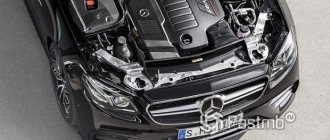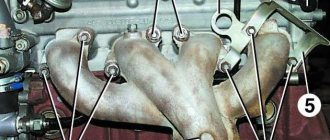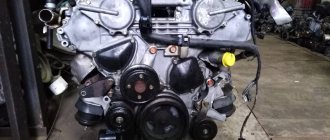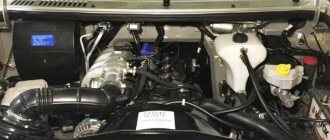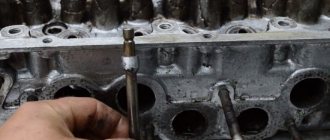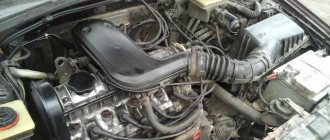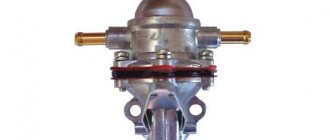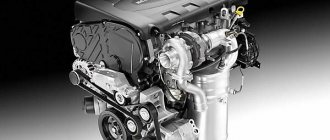Motor 2101 “Kopeyka”
It’s no secret that the first “Kopeyka” is a prototype of the Italian FIAT 124.
Accordingly, the first of the VAZ engines was initially only a modification of its predecessor, a kind of tuning of the VAZ engine.
The characteristics of VAZ engines have been changed:
- Thanks to the transfer of the camshaft from the lower to the upper part, an increase in the cylinder diameter by 3 mm, and a decrease in the piston stroke by 5.5 mm, the unit became more throttle response due to its transformation into a “short-stroke” one. The speed picked up faster, and throttle response began to be felt more strongly with sudden changes in the accelerator position.
- The only drawback of the engine at that time, which received the marking 2101, was the increase in noise.
- 4 years later, after the modification of “Kopeyka” 21011, a modernized VAZ engine of the same name appeared with markings identical to the model number. It began to differ from its recent ancestor in the following indicators: the VAZ engine displacement increased from 1200 to 1300 cm3, the cylinder diameter increased by another 3 mm, and the power increased by 3 “horses”. This VAZ engine was installed on both 01 series models and subsequent 2102 models.
- Carburetors for these engines were produced in 3 series until 1978, and later the Ozone 2105 appeared, which acquired an autonomous idle system, slightly changing the technical characteristics of the VAZ engine. These carburetors became much more practical, the car started easier in cold weather, and the quality of the fuel was less reflected in idling and sharp pressure on the accelerator.
Further tuning of the VAZ engine consisted of strengthening the transmission, which Italian engineers liked, and later they began to use Soviet modifications on their units.
Later, exports began to spread, and for the first time a rotary engine in a VAZ appeared on cars sent to neighboring countries.
This was the first successful experiment, but due to the difficulty of repairing such a unit and the virtual lack of spare parts, over time these types of motors became unpopular. Although analysts predicted a good future for units of this type, it was only necessary to properly establish the spare parts market.
Boring an internal combustion engine
Let's consider the first option, forcing. To do this, you need to bore the cylinders.
The standard version of the eight-valve six engine has a volume of 1,600 cubic centimeters, four hundred per cylinder. When boring, you will have to remove a certain layer of metal on the cylinder walls. This can only be done on special machines.
You can remove as much metal as the walls will allow. But do not forget to take into account the peculiarity - in the factory design the walls were designed for a certain mileage, and boring will significantly reduce this figure.
The essence of the forcing method is boring on a special machine and installing a new, enlarged piston. This modification option will make it possible to increase the power by more than a dozen “horses”.
Motor VAZ 2103
Since the late 70s, cars produced on special order, for example, for some police units, have had a completely new power unit, which has different technical characteristics, unlike other VAZ engines.
It was installed both on the later Kopeykas and on its successors - export 2102, 2103, 2107 and later on 2121, 21053.
These VAZ 2103 engines have become an absolute novelty (plural, but before and after everything is singular). Thanks to its dynamics, they allowed it to accelerate to 100 km/h in less than 17 seconds.
Such indicators became possible due to a number of changes:
- The volume increased to 1500 cm3;
- The piston stroke increased by 14 mm;
- maximum power became 77 hp. With. ;
- torque was determined for the first time. On this type of VAZ engine it became 104/3400.
The cylinder block is made of a special cast iron alloy, the cylinder head is made of aluminum. These rules were mandatory for all types of engines, and the fundamental difference was in the diameter of the cylinders. If for units 21011, 2105 and 2106 it was within 79 mm, then in 2103 it became 76 mm.
Another positive feature of this model is the ability to install crankshaft 21213, which has identical parameters, but improved technical characteristics of the VAZ engine.
In addition, the 2103 can be equipped with both classic and contactless ignition. Rebuilding the engine was not particularly difficult for specialists, and the availability of spare parts in terms of availability and pricing did not force the owner to search for places and means of purchase for a long time.
Engine under the designation ZMZ-409.10 (UAZ “Patriot”, “Pickup”, “Cargo”, “UAZ Profi”, UAZ-452)
The four-cylinder engines for passenger cars of the “409” family with a displacement of 2.7 liters include 9 modifications. The most massive line of power units.
Initially, the ZMZ-409 motor, in turn, built on the basis of the 406, an engine with a difficult fate, became the “mother” version of numerous modifications.
Initial characteristics of the 409.10 engine from the Zavolzhsky Motor Plant:
| Number and arrangement of cylinders | 4 vertically in a row |
| Working volume, liters | 2,693 |
| Block/cylinder head material | Gray cast iron/aluminum alloy |
| Cylinder diameter, mm | 95,5 |
| Piston stroke, mm | 94 |
| Number of valves per cylinder | 4 |
| Rated gross power at 4600 min, l. With. | 142,8 |
| Maximum gross torque at 3900 min, Nm | 230 |
| Compression ratio | 9,0 |
| Environmental class | Euro-0 (2) |
The engine was installed on the UAZ Patriot and Hunter SUV models. Already on its basis, numerous and gradual improvements were made, which were able to maximize the life of a fairly unpretentious, although not problem-free, engine.
Motor VAZ 2106
The baton of the engine, which became a real breakthrough in the Soviet market, was taken over by the VAZ 2106 engine.
It became a natural modification of the 2103 in order to increase the technical characteristics of VAZ engines in the direction of power.
The engineers achieved it:
- increasing the working volume to 1600 cm3, using the cylinder diameter, which again became 79 mm.
- The pistons for this VAZ engine were used from 21011 and it, like the donor, had two repair sizes. These VAZ engines had no other fundamental differences from the 2103, since they were equipped in the same way as their older relatives, with an “Ozone” carburetor and an ignition distributor with the same vacuum regulator.
But the 2106 engine did not find much sympathy among the owners, just as rotary engines on VAZs were once exported, since the owners of 2103, 2121, 2107 tried to select the more reliable VAZ 2103 engine.
This was due to the lower viability of the 2106 and instability of operation when using lower quality fuel. The saddest outcome was burnout of the valves and the unit required major repairs in these cases much more often than 2103.
Tuning
It is noteworthy that tuning a VAZ engine, as well as its repair, is possible for any owner who has at least a little knowledge of the technical characteristics of VAZ engines and has encountered repairs or overhauls of the engine.
But here the choice is between efficiency and power. Knowledge of which engines bend the valves is also important. The approaches to them are very complex.
The most common is tuning the VAZ engine, which increases the output parameters. For example, installing a new camshaft with an adjustable pulley, replacing connecting rods and pistons to increase displacement.
Well, in order for the power to be realized into the dynamic data of the car, the gearbox ratios are changed. This is the most budget-friendly VAZ engine tuning without any outside interference in the auxiliary units, despite the fact that this same tuning can be much more extensive.
It is worth remembering that any increase in power leads to additional fuel consumption and reduces the life of the unit; accordingly, it requires increased attention to maintenance and replacement of consumables. Therefore, the issue of tuning must be approached painstakingly and it is advisable that a person well versed in this take part in this.
Source
Motor VAZ 21083
Before considering the characteristics of VAZ engines of a completely new principle, it is worth paying attention to such transitional units as 2108, 2110 and 2111, since it was with them that the era of fuel injection by injector and the birth of front-wheel drive began.
Both of these engines are installed on models 2108, 21083, 2109, 21099, so it is currently very popular to replace an old carburetor engine with an injection engine, due to the many advantages of the latter.
What changed:
- The fundamental difference between the 21083 engine, like its predecessor 2108, was that it had to be transverse in placement due to front-wheel drive. The fundamentally new piston, which used a special micro-profile, retains lubricant much better than the early 2103, which was coated with tin.
- ICE 21083 is modified with a cylinder diameter of up to 82 mm, a working volume of up to 1500 cm3, and a maximum power of 65 hp. With. increases to 68, and torque from 95 to 100.5/3400.
- The timing drive of VAZ engines of the 8th family becomes belt driven, unlike the 2103, where there was still a chain. The quality of this change is certainly debatable, but every car enthusiast finds positive and negative sides in any type of timing drive.
- New features in the VAZ 2108 and 21083 engines include a new carburetor, which becomes much more economical than its predecessor, a completely different oil pump, driven by the crankshaft; a gasoline pump with outlet and inlet pipes on the same line, as well as a structurally different water pump.
Pros and cons of the ZMZ 409 engine
The simplicity of the design leaves its mark on the endurance of the engines in this series. Overcoming 300 thousand km or more is not a big problem for this type of engine. Basically, everything will depend on the operating conditions, maintenance and technical fluids used.
A clear advantage is the ability to be repaired not only in the garage at minimal cost, but also the ability to carry out repairs in the field. There are many stories about how jeepers drove UAZs out of the wilderness with problem engines. Nevertheless, the main criterion for choosing an engine (applies to many domestic power units) - the need to have mechanic skills - remains relevant for these power units.
Motor VAZ 2111
As mentioned above, the VAZ 2111 engine is the beginning of the era of distributed fuel injection. The appearance of cars of the “tenth family” allowed engineers to work in a qualitatively new direction, and in general, it was successful, completely changing the standard operating parameters of VAZ injection engines.
Motor 2111, like its successors 2112, 21114, 21124, 21118, are installed on car models 2108, 2109, 21099, 2110, 2111, 2112, 2114, 2115 in their various modifications, as well as on Lada Kalina. Many owners of old carburetor cars, without betraying their favorites, simply install a new injection unit in their cars, thereby extending their life by more than a dozen years.
What changed:
- Over a fifteen-year period, these units changed their volume from 1500 cm3 to 1800, and their power increased by 20 hp. With. And if the 2111 engine is a kind of modification of the 21083 and 2110, distinguished by additional mounting holes for the generator, an ignition module and a knock sensor, then, for example, the VAZ 21124 engine is a fundamentally different unit. Chip tuning of the VAZ engine originates from it.
- The only controversial point in the particularity of these VAZ engines is the increase in the number of valves from 8 to 16. And if you are wondering on which engines the valves bend when the timing belt breaks, then you need to remember only one modification of the engine: 2112, despite the fact that it one of the most common VAZ engines for tuning.
- In addition, the VAZ 2112 engine has completely different characteristics among VAZ engines and other typical operating parameters of VAZ injection engines. Unlike 2111, the power here has been increased to 93 hp. With. (2111 – 78), torque 127/3700 (115/3000), with a reduced volume from 1600 to 1500 cm3.
- Another camshaft appears here, as well as a different air supply system to the cylinders. This engine, naturally, has become more powerful, but the driver would rather prefer a calmer and more economical driving style due to the torque at low speeds.
- The difference between the later 21114 and 21124 is that the height of the cylinder block was increased by 2 mm, and the crankshaft stroke increased from 71 to 75.5. These technical characteristics determined the addition of volume to the VAZ engine up to 1600 cm3.
- Plus, the fuel system with the injector ramp has been slightly modified, the fuel return line has been eliminated, and a catalytic converter has been installed.
- The fundamentally new ignition system is now a four-terminal coil, and not an ignition module, as on the 2111. The quality of this ignition is certainly better, but some problems may appear during the plant in winter, but this is only out of habit.
Most often, when choosing a car, taking into account the technical characteristics, owners try to avoid this unit, but this is done only by those who are not very meticulous about caring for the engine, since troubles can be avoided by timely replacement of the belt, and the purchase of this part should be treated more responsibly .
When choosing a belt, you can only trust a trusted manufacturer, information about which can be found on the Internet or from friends, since you cannot trust salespeople in stores 100%. Frequent counterfeits of well-known companies cannot be ruled out, which leads to underestimation of a particular belt. Accordingly, at least within the time specified by the standard characteristics, the belt simply must be checked by the owner.
The most successful motor in Russia - the main questions for the designer
At one time, the engine for the VAZ-2108 and its modifications became, like the front-wheel drive car itself, a milestone for the domestic automobile industry. To one degree or another, modern VAZ engines originated from this engine.
How did you start designing the engine?
We started with technical requirements for the engine from the vehicle layout department. Power, weight, dimensions were indicated there. At the development stage, many options were discussed (for example, there were thirteen options for combustion chambers), but, of course, with reference to the equipment existing at the plant.
What imported analogues have you seen? What did they borrow from them?
Engines from FIAT, Alfa Romeo, Volkswagen and others were studied and tested, but in smaller quantities. The valve drive, pushers and shims were completely borrowed from the FIAT engine.
How freely did you work?
The engine layout is free. But the design of the units and assemblies had very strict requirements for the unification of parts and technologies with those available at VAZ’s main production. The engine was technologically unified with classic engines in terms of cylinder diameter, diameter of the crankshaft main and connecting rod journals. The piston pins and valves were also unified (except for the length of the rods).
Have you tried installing engines from the classics on the G8?
Engines from the “classics” were never installed on prototypes. An additional boss on the clutch housing was provided for the installation of our diesel engines, which were installed on several prototypes of the VAZ-21085. But not as planned, but on an initiative basis.
Why did you choose a 1.3 liter engine as the base one, and not just a 1.5 liter one?
Then it was believed that the most popular would be a car with a 1.3 liter engine, similar to the VAZ-2101 with a 1.2 liter engine.
What other engines were installed at the beginning?
The technical requirements for cars of the VAZ-2108 family specified engines of 1.1 liters, 1.3 liters and 1.5 liters. According to the results of road tests, the 1.1 liter version was considered unsuccessful. But at the request of marketers, it was created with an eye on Western markets. However, the demand for such a 54 hp engine. It turned out to be very small, and they didn’t do it for long.
Why did you choose a belt and not a chain for timing drive?
An analysis of the designs of imported engines confirmed the feasibility of using a timing belt. Thanks to him, the noise level was noticeably reduced. And the reliability of the chain was equal to the reliability of a toothed belt. Of course, subject to the schedule of routine maintenance in operation.
What was the contribution to the creation of the Porsche engine?
The German contribution was of great importance, if not decisive. Our specialists have undergone advanced engine development school. From the Germans we received finishing techniques and a list of equipment for engine boxes operating using modern methods. Porsche hired contractors to improve components, assemblies and parts of the 1.3 liter engine: oil pump, pistons, piston rings, head gasket, etc.
Did you immediately plan to increase the volume of cylinders? What about a 16-valve head?
Engines up to 1.6 liters were provided. But a sixteen-valve head was not provided. At first there were enough problems with the eight-valve one.
What engine life were you planning on?
They expected a resource of 200,000 km.
If you look at the engine from a modern perspective, it turned out well.
. very successful! By the way, there were even articles in German magazines about this at that time. But the main thing is that its merits have been proven by time.
Source
